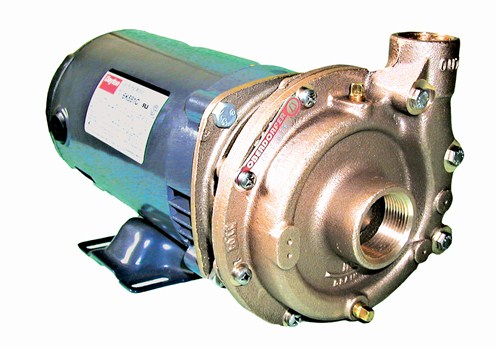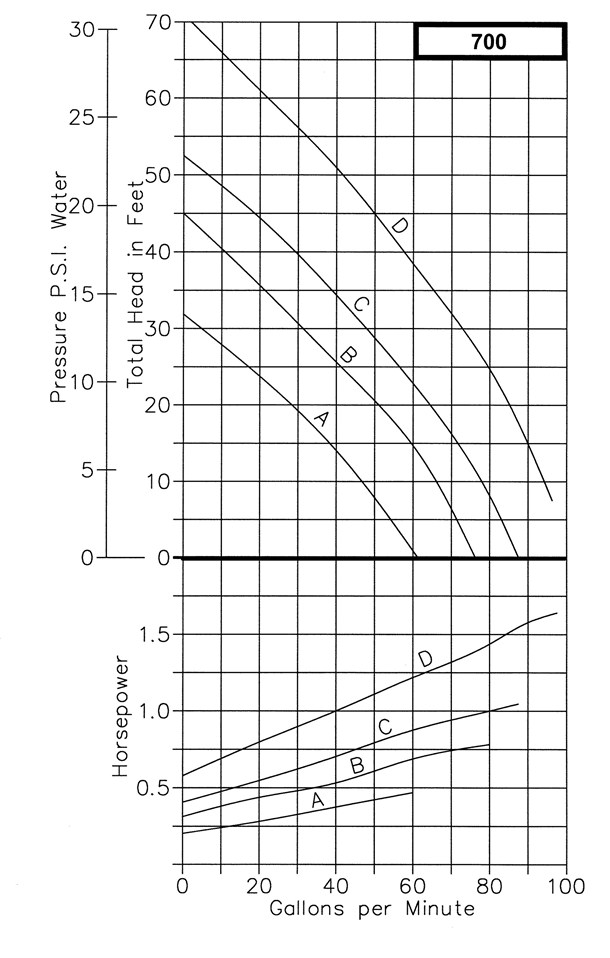Oberdorfer 700
Use for Calcium Chloride, Magnesium Chloride and other De-icing Liquids
This close coupled centrifugal pump uses a mechanical type shaft seal with a Nitrile rubber element. It is suitable for water, oils, and some mild solvents. It is limited to 212o F. fluoroelastomer seals and polytetrafluoroethylene (PTFE) seals are available for severe solvents, difficult chemicals, and elevated temperatures. The impeller is attached directly to the motor shaft. This pump can handle small impurities in the liquid. The flow of a centrifugal pump can be conveniently controlled by a throttling valve in the discharge line without the need for a relief valve. In centrifugal pumps, the horsepower demand will increase as the pressure increases. Maximum horsepower occurs with a wide open discharge.

Features:
- Rugged bronze Construction
- Quiet Operation
- O-Ring housing seal eliminates gasket problems
- Wide Hydraulic Range – Four Impeller sizes
- Handles contaminated liquids
- Discharge port orientation flexibility – 8 positions
- Mechanical Seal – Carbon/Ceramic- Nitrile – standard, fluoroelastomer (S10) optional. polytetrafluoroethylene (PTFE) (S11) optional
- Pump heads mount to standard footed NEMA 56J jet Pump Motors
- Shafts: 416 Stainless
- Multiple motor options available
Drive
This close-coupled pump uses a standard NEMA C-Flange Jet Pump Motor with weld-on base and threaded shaft end to accept the pump impeller. Single phase motors are non-reversible and are wired for the proper pump rotation which is counter-clockwise looking at the inlet end of the pump. (See the dimensional drawing.) Three phase motors must be checked out for proper rotation when the pump is installed. Interchanging of any 2 wires in a 3-phase system will reverse motor rotation.
Liquids & Temperatures
The special pump alloys used provide corrosion resistance to many liquids including water, water solutions, and a wide range of commercial chemicals. Questions as to the chemical compatibility of special liquids should be referred to the factory.
The pump uses a mechanical type shaft seal with a Nitrile rubber element. It is suitable for water, oils, and some mild solvents and it is limited to 212oF and 75 P.S.I. fluoroelastomerseals and Polytetrafluoroethylene (PTFE) seals are available for severe solvents and difficult chemicals.
Viscous liquids with a maximum viscosity of 2000 Saybolt Seconds Universal can be pumped. However, when pumping viscous liquids as compared with water, a reduction in flow and pressure occurs and the required horsepower rate increases. Liquids heavier than water require additional horsepower in direct proportion to the increase in specific gravity. Liquids contaminated with small solids or abrasives can be handled, but a reduction in mechanical seal life must be expected.
Suction Lift
These centrifugal pumps are not self-priming. They must be installed below the liquid level so that the liquid flows to the pump by gravity (flooded suction). However, if a foot valve is used at the beginning of the suction line and all air is bled from the pump by manual priming, the pump will lift on the suction side up to 15 feet. Such a system relies entirely on a non-leaking foot valve for starting capability.

